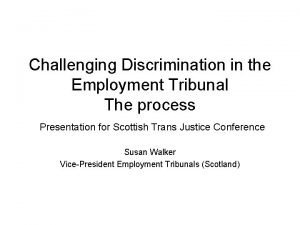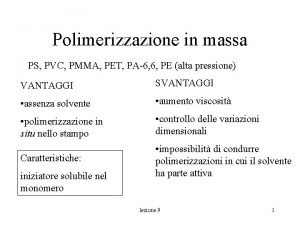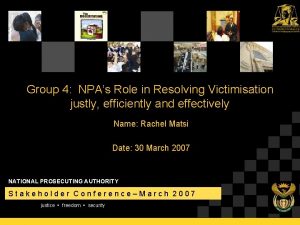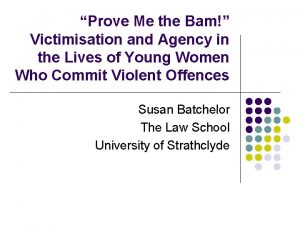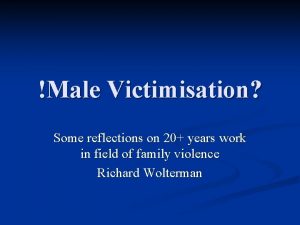Victimisation 60years Year 2008 2018 Professor Saviour Formosa
















- Slides: 16

Victimisation – 60+years Year 2008 -2018 Professor Saviour Formosa Crime. Malta Observatory Social Affairs Committee Presentation – 13 March 2019

Scope: To understand the realities of Crime in the Maltese Islands Understanding the Situation Malta in the EU UNODC United Nations Office on Drugs and Crime Rankings: 2015 (UNODC latest comparative EU 28 data) Theft – 4 th (higher than EU average) Homicide - 14 th (lower than EU average) Assaults – 14 th (lower than EU average) Robberies – 9 th (lower than EU average) Burglary – 16 th (lower than EU average) Drugs – 20 th (lower than EU average) Sexual Offences– 12 th (lower than EU average) Rape – 15 th (lower than EU average) Sexual Assault– 13 th (lower than EU average) Malta has highest number of Police Officers per 100, 000 persons (519 officers)

Online Surveys… Perceptions Numbeo. com

Long-term analysis exhibits a continued generic trend line decrease in reported crime Trends What did & What should have occurred 2018 experienced a major decrease where crime reports show a reversal of the 2010 -2016 phenomenon – a 7 point decrease 15, 925 reported offences The Maltese affluence rate results in wider Opportunities for offenders, such that crime has diversified The increasing resident population (460, 000) should have rendered an additional 1, 563 victims in 2018 The steady increase in tourist arrivals (2, 600, 000) should have rendered an additional 3, 588 victims in 2018 Malta’s crime rate from 42 crime per 1000 persons to one where the rate has reached 34 crimes per 1000 persons

A major shedding of crime by 7% or 1, 211 cases Bodily harm has been pushed further down the league due to a relatively large increase in fraud Displacement is also very evident as the migration of crimes from one zone to another becomes more pronounced. Trends Significant Firsts San Giljan’s rate of crime dropped from a height of 19. 5 in 2012 to 10. 6% in 2017 and again to 9. 4% in 2018, a drop of 18% from 2017, the lowest in the last 14 years. In terms of societal reaction, moral panic still plays a part in rendering a perception that crime is increasing, when the facts depict a stabilised scenario. Expected victims: 21, 600 - Observed victims: 15, 925 Expected Maltese victims: 13, 800 victims – Observed 12, 237 victims – 33 per 1000 Expected Foreign victims: 7, 800 victims – Observed 4, 212 victims – 3 per 1000 Victims are mainly male Maltese residents, aged falling within the 40 -59 year cohort. Victims aged less than 18 years fell to 3. 3%. Foreign victims hail from 161 countries Mondays, January-May/August and the 00: 00 -03: 00 comprise the main functional temporal aspects of Maltese crime reporting.

2018: 15, 925 reported offences. Figures Main Shifts A major decrease in crime reports over the 2018 period comprising an absolute decrease of 1, 211 crimes (7. 1%) indicating a reversal 2010 -2016 ‘increase’ phenomenon. The previous singular crime phenomenon has been brought to heel - Pickpocketing decreased by 995 offences in 2018, a decrease of 46% from the previous year from 2, 144 cases. Most other categories of theft have decreased apart from theft from factories by employees, mugging, religious temples, occupied residences, shop lifting, snatch and grab, theft from sea craft and theft from vehicle.

Theft comprises 41% of all offences reported to the Police, down from 48. 2% in 2017, the lowest in 14 years (2004) when the rate was that of 62. 4% of all reported offences. Damages, has seen a slight increase to 24. 7% of all offences up from 22% in 2017, increasing through Involuntary Damage by Hit and Run incidents and Wilful damage by Other Means. Figures Domestic Violence has increased its previously stable 7% rate to 8. 4% of all offences, to reach 1341 cases, with a 10% increase in Psychological Harm and 8% Slight Bodily Harm with Physical Force. Main Shifts The 4 th highest ranking offence, Bodily Harm, has been pushed to 5 th ranking. Bodily Harm which had registered a year on year decrease initiated in 2009 down to 5%, increased slightly to 5. 6% In turn, Fraud is now 4 th ranking, again experienced an increase of 31% (245 additional cases) over the previous year reaching 1032 cases in 2018. The main increase was registered as Fraudulent Gains. These 5 categories of crimes comprise 88. 1% of all crime reports

Computer related crime experienced a 20% increase over the previous year, through password disclosure, unauthorized access and copying / disclosure / possession of data. Figures Main Shifts Threats and Public Violence has increased to 322 in 2018, mainly through stalking, blackmail and causing fear of violence, though harassment experienced a reduction in reporting. Theft from Residences has again increased by 31 cases or 5% as compared to 2017 reaching 623 cases.

Victims are mainly Maltese residents (74. 3%), followed by UK residents (2. 5%), whilst Italians, French, Germans and Spanish comprise other source countries whose residents suffered victimisation. Main age cohort that is victimised pertains to the 40 -59 year cohorts, followed by the 20 -29 year and the 30 -39 year and the 60+ cohorts respectively. Domestic violence was mainly experienced by the 40 -59 year cohort, followed by the 30 -39 year cohort. Under 18 were mainly victims of pornography and sexual offences, when compared to the other age cohorts, whilst the 60+ cohort were mainly victims of forgery, fraud and theft. In terms of gender, main victims’ gender is male, growing over the years up to 57. 6% in 2018, whilst females make up 42. 2% of victims. Females were mainly victims of prostitution, trafficking in persons, crimes against public peace, sexual offences, pornography and domestic violence. Males were mainly victimised for arson, violence against public officer, forgery, damage, bodily harm and fraud.

Persons aged 60+ have seen a steady increase in victimisation which was reversed in 2018 Victims: 60+ Counts Year 2008 2009 2010 2011 2012 2013 2014 2015 2016 2017 2018 Total Count Difference % 1650 1584 -66 -4. 0 1829 245 15. 5 2040 211 11. 5 2184 144 7. 1 2516 332 15. 2 2575 59 2. 3 2608 33 1. 3 3114 506 19. 4 3157 43 1. 4 2805 -352 -11. 1 26062

Victims of Theft (62%), Damages (18%), Domestic Violence (4%), Bodily Harm (4%) and Fraud (3%) 2017 – 2018 changes saw decreases in Theft (-25%) and Attempted Offences (-14%) Victims : 60+ 2017 – 2018 changes saw increases in Damages (+2%), Domestic Violence (+15%), Bodily Harm (+56%) and Fraud (+58%). 2008 -2018 Offence 2008 THEFT 1021 DAMAGE 251 ATTEMPTED OFFENCES 192 DOMESTIC VIOLENCE 26 BODILY HARM 81 FRAUD 41 ---Grand Total 1650 2009 2010 2011 2012 2013 2014 2015 2016 2017 Grand 2018 Total 1053 200 136 39 82 41 1227 250 146 45 78 41 1445 222 149 61 62 49 1409 319 187 83 68 51 1403 583 134 93 89 139 1519 563 144 95 78 102 1532 594 93 110 98 76 1962 630 115 121 94 92 2042 552 171 124 72 89 1523 563 147 143 112 141 -1584 -1829 -2040 -2184 -2516 -2575 -2608 -3114 -3157 16136 4727 1614 940 914 862 -- 2805 % of Total Diff Count 62 18 6 4 4 3 -26062 -519 11 -24 19 40 52 -- 100 Diff % -25 2 -14 15 56 58 -- -352 -11

2017 – 2018 changes in as follows: Theft: -1% Residences occupied and -9% residences exterior Theft: +5% Residences vacant Theft: -47% Pick-Pocketing Victims : 60+ 2008 -2018 Domestic Violence: +44% in Psychological Harm Domestic Violence: -17% GBH Domestic Violence: -50% SBH Bodily Harm: +53% SBH and +70% GBH Fraud: +65% in Fraudulent Gains and -17% in misappropriation

Gender: 64% Males – 36% Females Nationality: 78% Maltese – 22% International Victims : 60+ 2008 -2018 Time of Victimisation: 08: 00 – 12: 00 29% 12: 00 – 18: 00 30% 18: 00 - 21: 00 11% 21: 00 – 08: 00 30%

Changes from a multi-thematic to a spatial to a virtual structure From a What occurs approach to Where they occur, How they occur and Why Morphing of the Maltese Safety Scenario - a way forward From a Social-Space scenario to a Private-Space scenario to a Technological-Space Move away from the perception that the mitigation is simply a role that the Police force should fulfil Need for Local Councils and Regions to take up mitigation measures, whilst the business community is also encouraged to put in its fair share to reduce offences within their businesses and also to directly cooperate in structural-financial-operational activities with the Malta Police Force to help increase safety and security in their areas. Move towards collective Social Responsibility Social Capital is provided through the PREFET structures, of which the Police Force form a part, but the essential aspects that will pivot towards offence mitigation lies in the enhancement of Social Cohesion

Requiring a mitigation shift in policing, personal safety and preparedness in technological advances. Morphing of the Maltese Safety Scenario - a way forward Reduction of Moral Panic by the media and the Responsible Others Emphasis should be now taken to the next level through an educational awareness campaign starting from the early ages to elder adults The implementation of the 2017 Crime Prevention Strategy is a veritable vehicle for such a process Need to initiate thinking about new crimes that will occur over the next years: crimes that have yet to be conceived by offenders as the next societal change will occur, mainly in the digital arena

Victimisation – 60+years Year 2008 -2018 Thank You saviour. formosa@um. edu. mt
 Victimisation meaning
Victimisation meaning Example of victimisation
Example of victimisation Comwha
Comwha 2008 2008
2008 2008 Promotion from assistant to associate professor
Promotion from assistant to associate professor Aap 2018 um professor ministra um curso especial
Aap 2018 um professor ministra um curso especial Distribuzione formosa plastics
Distribuzione formosa plastics Formosa laboratories, inc.
Formosa laboratories, inc. Netbook conectar igualdad
Netbook conectar igualdad Mga natutuhan
Mga natutuhan Cetem formosa
Cetem formosa Puerto de palos formosa
Puerto de palos formosa Moodle ria formosa
Moodle ria formosa Definition of factoring by grouping
Definition of factoring by grouping Hino debaixo de uma mui formosa tamareira
Hino debaixo de uma mui formosa tamareira Qual foi o marco inicial do trovadorismo
Qual foi o marco inicial do trovadorismo Formosa
Formosa
